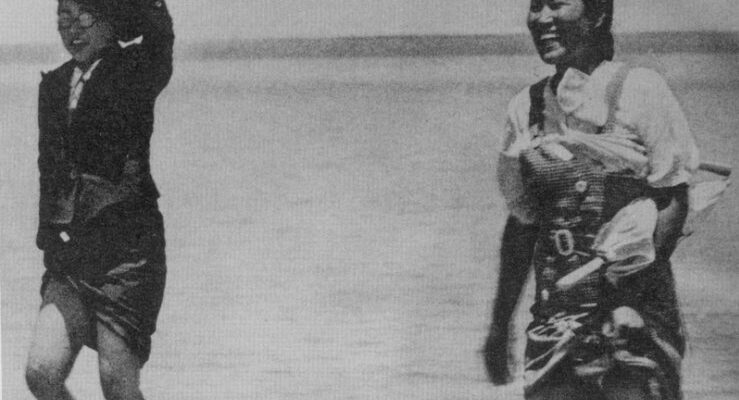Tension continues to remain between South Korea and Japan over issues that arose during World War II. Recently, an association funded by Japan to support former Comfort Women as reparation for World War II was shut down by Seoul. As well as the issue of Korean Comfort Women, a dispute between the two countries, over reparation for Korean laborers who worked for Japanese corporations during the war persists. Why do these issues continue to taint relations between South Korea and Japan? Will they ever be resolved?
Who Were the Korean Comfort Women?
In the time of Japanese Imperial occupation of South East Asia, a system of brothels was established by the Imperial Army in an effort to reduce the occurrence of wartime rape by soldiers. These brothels, known as “comfort stations,” were run by locals and served military personnel in occupied countries. The comfort stations employed local women who were known as “ianfu”, a Japanese euphemism for “prostitutes” which translates to English as ‘Comfort Women’.
According to a recently reviewed estimation, there were around 20,000 Comfort Women who served throughout the Japanese empire. This number was previously estimated to have been higher but was disproved by a falsified newspaper publication by a former Japanese soldier.
With the collapse of the Japanese Empire following the atomic bombings of Hiroshima and Nagasaki, the system consequently dispersed, and the Japanese-occupied countries gained independence. Former Korean Comfort Women as well as those who served elsewhere have since come forward to publicly share their experiences from the war, demanding Japan to apologize and offer compensation. In response, Japan has amicably made several apologies and established funds and treaties in an attempt to achieve reconciliation.
The Pathway to Healing
On June 22nd, 1965, Japan and South Korea signed the Treaty on Basic Relations. This treaty served to establish basic diplomatic ties between the two countries and was the outcome of discussion of this topic that occurred between 1951 and 1965. This document caused much debate regarding the most recent row over forced labor between Japan and South Korea, as the settlement of all compensation claims between both countries was to be through the approval and implementation of this treaty.
However, much to the disappointment of the Japanese delegation, former wartime laborers of the Nippon Steel & Sumimoto Metal Corporation were awarded compensation from the South Korean supreme court. In regard to the Japanese occupation of Korea, the treaty additionally stated that “It is confirmed that all treaties or agreements concluded between the Empire of Japan and the Empire of Korea on or before August 22, 1910 are already null and void.”
Additionally, the settlement of various issues including Comfort Women and property claims was agreed upon by both countries. In return, Japan gave a $300 million grant, $200 million in official government loans as well as additional loans of $300 million from a private trust fund.
In conjunction with these agreements, the Asian Women’s Fund, which was established by the Japanese government in 1995, aimed to further settle diplomatic relations with South Korea through providing financial compensation to surviving South Korean Comfort Women, as well as those from Taiwan, the Philippines, the Netherlands and Indonesia. The Japanese government contributed 4.8 billion Yen to the fund and around 600 million Yen were raised through private donations. The responsibility to distribute rested on the fund. After the war, many former Korean Comfort Women faced extremely difficult and socially isolated lives, being outcast as impure and unworthy of respect. Many of these women lived alone and unmarried for many years after the war.
Japan–South Korea Comfort Women Agreement, 2015
An agreement between Japan and South Korea regarding the issue of Comfort Women was signed on December 28th, 2015. The agreement intended to resolve the long-standing issue “finally and irreversibly.” The agreement was widely supported by several nations including the United States, the United Kingdom and Germany.
Within the agreement, there were three main pillars. The first pillar contained a sincere apology from Japan for their conduct in relation to Korean Comfort Women during the war. In the second pillar, Japan agreed to provide South Korea with 1 billion Yen in order to establish a foundation to support former Comfort Women. Thirdly, the two countries agreed to resolve the outstanding issue regarding the Comfort Women statue built in front of the Embassy of Japan in Seoul.
While the first two pillars of the agreement were adhered to by Japan, South Korea did not proceed with the removal of the statue. Another statue was even erected in Busan, in front of the Japanese consulate. Internationally, both statues are a violation of the 1961 Vienna Convention which states the obligation of host states to prevent “any disturbance of the peace of [the diplomatic mission/consular post] or impairment of its dignity”.
Another issue that continues to strain diplomatic ties between both countries is the construction of Comfort Women statues in several locations, worldwide. In addition to the Wednesday demonstration in Seoul, various civil groups have funded the creation and maintenance of statues symbolizing former Comfort Women. Japan is deeply offended by these actions and views them as an obstacle created by Korea and its representative groups in the restoring of peaceful diplomatic relations between the two nations.
Over the years, Japan has offered several concessions and reparations and has acted in accordance with the agreement. Therefore, the pathway to peace between the two countries seemingly lies in the hands of South Korea. Hopefully, South Korea will take a necessary step to satisfy the surviving Comfort Women in time for them to witness.

